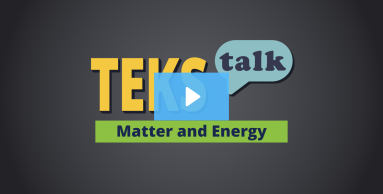
Knowledge and Skills Statement
Provide students with a selection of options that can be sorted by their observable physical characteristics. Touch can be used to identify an object's texture, relative temperature (warmer or cooler), flexibility, size, shape, and whether an object is a liquid or a solid. Students may also use sight to determine color, size, shape, and whether an object is a liquid or solid. Students might sort objects into categories such as rough or smooth, bendable or rigid. After students practice classifying types of matter, provide them with a prompt like the one below.
Example Writing Prompt: A student in second grade states that her building brick is a solid. Another student states that they can pour out a bucket of building bricks so it must be a liquid. Have students record in their notebook whether building bricks should be classified as solid or liquid and support their claim with observable physical properties. Student responses should explain that even though you can pour a bucket of building bricks, one individual building brick keeps its shape and cannot be poured. They might also indicate that a building brick is not wet like a liquid.
The further explanation is designed to be a resource for educators that helps them better understand the topic their students are learning. Further explanations may be written at a more complex level than would be expected for students at the grade level.
As an educator, it is important to consider appropriate way to observe physical properties in grade 2. For example, touch can be used to identify an object's texture, relative temperature (warmer or cooler), flexibility, size, shape, and whether an object is a liquid or a solid. Students may also use sight to determine color, size, shape, and whether an object is a liquid or solid.
One common misconception is that any substance that can be poured is a liquid. If a solid is sufficiently small, it can be poured out of a container, like rice from a cup into a bowl. While collectively, the grains of rice can be poured, rice is still a solid. In grade two, students are only looking at observable physical properties of matter. In third grade, students will describe particle behavior in solids, liquids, and gasses. In middle school, students will be introduced to the concept of atoms as the building blocks of matter.
Research
Keeley, Page. “Formative Assessment Probes: Is It a Solid? Claim Cards and Argumentation.” Science and Children (2020): 26–28. http://www.jstor.org/stable/43176441.
Summary: By the end of 2nd grade, students should know that solids and liquids exist and how to tell them apart. Many students are taught that solids keep their shape and liquids take the shape of their container, but these descriptions can cause misconceptions. Students often believe that solids are hard and cannot be soft. In this article, the teacher has students determine if an object is a solid or a liquid using its properties. Students make their claims about whether an object is solid and defend their claims using evidence. The other students do not give their opinion at first but just listen. Teachers listen for misunderstandings (such as flour being called a liquid because it is soft and pourable). These claims can be added to a chart for the class to discuss. It was obvious that most of the misconceptions were about soft, flexible, and stretchy solids. Students should then be allowed to observe things like flour to see that it is a material made up of many small solids. The teacher can then use the claims chart to assess student understanding.
Research
Robertson, Bill. “Science 101.” Science and Children 50, no. 9 (2013): 72–73. http://www.jstor.org/stable/43176450.
Summary: Misconceptions about classifying objects as solids or liquids are explained in this article. Most people believe that solids have a definite shape, but some solids, like rubber, do not necessarily have a definite shape and can be manipulated due to their flexibility. There are some solids that, when heated, are transformed into a liquid, and solids and liquids added together can sometimes form new materials. The distinction between what makes something a solid or a liquid is not always clear-cut and can cause confusion among students.
